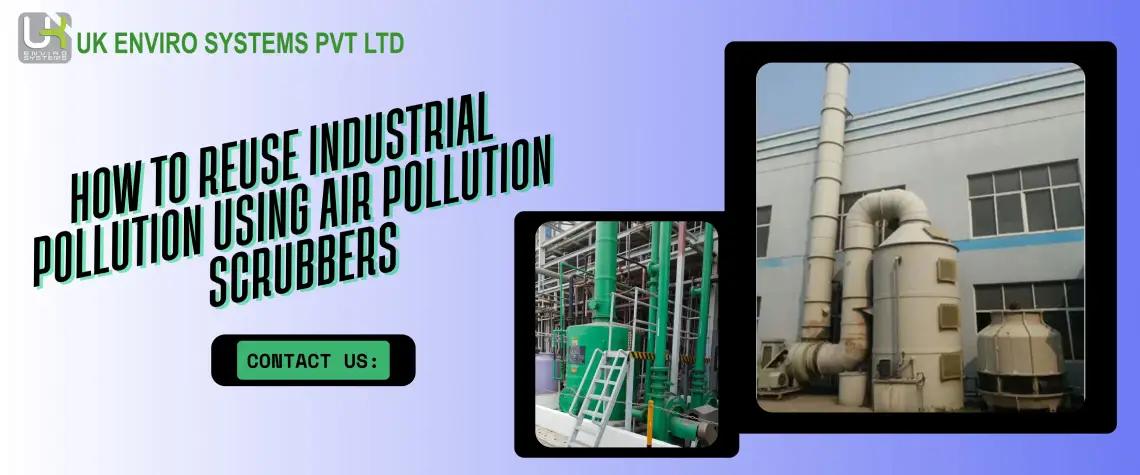How to Reuse Industrial Pollution Using Air Pollution Scrubbers

Industrial growth often carries an invisible cost: air pollution. For manufacturing hubs like Ghaziabad, managing toxic emissions isn’t just about compliance—it’s a sustainability imperative. Advanced Air Pollution Control Scrubbers in Ghaziabad are emerging as transformative tools, not only capturing harmful pollutants but unlocking opportunities to reuse industrial byproducts, turning waste streams into valuable resources. Here’s how this technology is reshaping sustainability for Ghaziabad’s factories.
Table of Contents
ToggleThe Pollution Challenge in Ghaziabad’s Industrial Landscape
Ghaziabad, a critical NCR manufacturing cluster, hosts diverse industries:
- Metal Fabrication & Foundries (acid fumes, metal dust)
- Chemical Processing (VOCs, acidic gases, solvent vapors)
- Textile Dyeing Units (chlorine, sulfur compounds)
- Pharmaceuticals (solvent emissions, particulates)
- Food Processing (odors, organic volatiles)
Without effective control, pollutants like SO₂, NOₓ, HCl, HF, and particulate matter damage health, ecosystems, and infrastructure. Traditional “end-of-pipe” treatment often merely shifts pollution from air to land/water. FRP Scrubbers change this paradigm.
How Scrubbers Capture and Enable Reuse
Air Pollution Control Scrubbers in Ghaziabad (especially wet variants) remove pollutants by contacting contaminated gas with a liquid absorbent. The magic lies in what happens next:
- Pollutant Absorption:
Contaminants dissolve into the scrubbing liquid (e.g., water, alkaline solution). For example:
SO₂ + Ca(OH)₂ → CaSO₃ (Calcium Sulfite)
HCl + NaOH → NaCl (Salt) + H₂O
- Byproduct Formation:
The reaction creates recoverable compounds suspended in the scrubber slurry. - Resource Recovery:
These byproducts can be separated, purified, and reused:- Gypsum Production: Oxidizing sulfite slurry converts it into Gypsum (CaSO₄) – a core material for cement, drywall, and soil conditioners.
- Chemical Reclamation: HCl from pickling operations can be recovered as reusable hydrochloric acid.
- Metal Recovery: Scrubbers in electroplating capture metals like chromium or nickel for refining and reuse.
- Fertilizer Inputs: Ammonia-based scrubbers produce ammonium sulfate – a valuable fertilizer component.
- Water Recycling: Treated scrubber effluent can often be reused in cooling towers or non-critical processes.
Key Scrubber Types Driving Pollution Reuse in Ghaziabad
- Wet Packed-Bed Scrubbers: Ideal for soluble gases (HCl, NH₃, Cl₂). Use counter-current flow for maximum absorption. Enables high-purity chemical recovery.
- Venturi Scrubbers: Handle high-dust/high-temperature streams (foundries, incinerators). Capture fine particulates while dissolving gases.
- Dry & Semi-Dry Scrubbers: Use lime/activated carbon injections. Produce stable, non-leachable residues suitable for landfill cover or construction.
Why "Wet Scrubber AMC" is the Linchpin of Reuse Systems
For scrubbers to consistently enable resource recovery, they must operate at peak efficiency. This is where Wet Scrubber AMC (Annual Maintenance Contracts) become non-negotiable:
- Preventing Scaling & Fouling: Mineral buildup (e.g., gypsum scaling) reduces absorption efficiency. Regular AMC cleaning maintains flow rates and reaction kinetics.
- Nozzle & Packing Integrity: Clogged nozzles or damaged packing media cripple gas-liquid contact. AMC includes inspection and replacement.
- Pump & Fan Performance: Ensures consistent slurry circulation and gas handling capacity.
- pH Control System Calibration: Critical for optimal chemical reactions and byproduct quality.
- Sludge Management Systems: AMC covers dewatering equipment maintenance for efficient byproduct extraction.
Without rigorous AMC:
- Recovery rates plummet
- Byproduct contamination increases
- Downtime disrupts operations
- Compliance risks escalate
Implementing a Scrubber-Based Reuse System: Steps for Ghaziabad Industries
- Emission Audit: Identify pollutant types, concentrations, and flow rates.
- Scrubber Selection: Choose technology (wet/dry) tailored to pollutants and reuse goals.
- Reuse Integration: Design slurry handling, settling tanks, filters, and purification systems.
- AMC Partnership: Sign Wet Scrubber AMC with Ghaziabad-based specialists for lifecycle support.
- Byproduct Market Linkage: Partner with cement plants, fertilizer units, or chemical recyclers.
Benefits Beyond Compliance: The Reuse Advantage
- Cost Recovery: Selling gypsum, salts, or metals offsets scrubber operational costs.
- Reduced Waste Disposal Fees: Sludge volumes decrease; non-hazardous byproducts cut landfill costs.
- Resource Security: Recovered acids/water reduce raw material procurement.
- Enhanced ESG Credibility: Demonstrates circular economy leadership to investors and customers.
- Long-Term Equipment Health: Wet Scrubber AMC extends asset life by preventing corrosive damage.
Ghaziabad’s Opportunity: Leading the Circular Industrial Revolution
As a major industrial hub facing CPCB and NGT scrutiny, Ghaziabad is uniquely positioned to adopt scrubber-based reuse. Local advantages include:
- Proximity to Markets: Cement plants (gypsum users), chemical industries (acid reclaimers), and farms (fertilizer) are within reach.
- Technical Expertise: Air Pollution Control Scrubbers manufacturers offer custom solutions and local Wet Scrubber AMC teams for rapid response.
- Regulatory Incentives: State policies may support waste-to-resource projects.
Choosing the Right Partners in Ghaziabad
Select providers who offer:
- End-to-End Solutions: Scrubber supply + reuse integration + AMC
- Byproduct Validation: Testing and certification of recovered materials
- 24/7 AMC Support: Critical for minimizing production disruption
- Compliance Documentation: Assistance with PCB filings and audits
Conclusion: From Compliance to Circularity
Air Pollution Control Scrubbers are no longer just pollution traps—they are resource recovery engines. By capturing SO₂, HCl, ammonia, and particulates, industries in Ghaziabad can transform hazardous emissions into gypsum, salts, acids, and fertilizers, closing the loop on industrial waste.
The key to unlocking this potential lies in robust system design and unwavering operational excellence through Wet Scrubber AMC. Partnering with experienced Air Pollution Control Scrubbers suppliers ensures your scrubber isn’t just a cost center, but a generator of value, sustainability, and resilience. Embrace the scrubber revolution and turn your fumes into your next resource stream.
